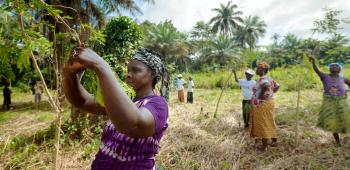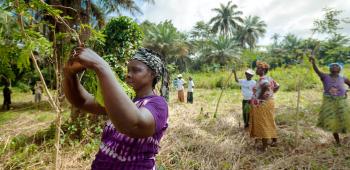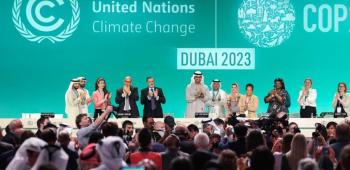Overview
Targets and Indicators

13.1
Strengthen resilience and adaptive capacity to climate-related hazards and natural disasters in all countries
13.1.1
Number of deaths, missing persons and directly affected persons attributed to disasters per 100,000 population
13.1.2
Number of countries that adopt and implement national disaster risk reduction strategies in line with the Sendai Framework for Disaster Risk Reduction 2015–2030
13.1.3
Proportion of local governments that adopt and implement local disaster risk reduction strategies in line with national disaster risk reduction strategies

13.2
Integrate climate change measures into national policies, strategies and planning
13.2.1
Number of countries with nationally determined contributions, long-term strategies, national adaptation plans and adaptation communications, as reported to the secretariat of the United Nations Framework Convention on Climate Change
13.2.2
Total greenhouse gas emissions per year

13.3
Improve education, awareness-raising and human and institutional capacity on climate change mitigation, adaptation, impact reduction and early warning
13.3.1
Extent to which (i) global citizenship education and (ii) education for sustainable development are mainstreamed in (a) national education policies; (b) curricula; (c) teacher education; and (d) student assessment

13.a
Implement the commitment undertaken by developed-country parties to the United Nations Framework Convention on Climate Change to a goal of mobilizing jointly $100 billion annually by 2020 from all sources to address the needs of developing countries in the context of meaningful mitigation actions and transparency on implementation and fully operationalize the Green Climate Fund through its capitalization as soon as possible
13.a.1
Amounts provided and mobilized in United States dollars per year in relation to the continued existing collective mobilization goal of the $100 billion commitment through to 2025

13.b
Promote mechanisms for raising capacity for effective climate change-related planning and management in least developed countries and small island developing States, including focusing on women, youth and local and marginalized communities
13.b.1
Number of least developed countries and small island developing States with nationally determined contributions, long-term strategies, national adaptation plans and adaptation communications, as reported to the secretariat of the United Nations Framework Convention on Climate Change
Progress and Info
Climate records were shattered in 2023, with the world watching the climate crisis unfold in real time. Communities around the world are suffering the effects of extreme weather, which is destroying lives and livelihoods on a daily basis. The roadmap to limit the rise in global temperature to 1.5°C and avoid the worst of climate chaos cannot afford any delays, indecision or half measures by the global community. It demands immediate action for drastic reductions in global greenhouse gas emissions in this decade and the achievement of net zero by 2050.
Target 13.1: o The number of disaster-related deaths and missing persons per 100,000 population (excluding COVID-19 deaths) has nearly halved from 1.62 in the decade 2005-2014 to 0.82 in 2013-2022. However, the absolute number remains high. Between 2013 and 2022, disasters worldwide claimed 42,553 mortalities each year. Further, the number of persons affected by disasters per 100,000 population has increased by over two-third, from 1,169 in 2005-2014 to 1,980 in 2013-2022.
o In 2023, 129 countries reported the adoption and implementation of national disaster risk reduction strategies, increasing from 55 countries in 2015. Among these countries, 122 countries have reported promoting policy coherence and compliance with the SDGs and the Paris Agreement as a key element in the strategy.
Target 13.2: The year 2023 broke every single climate indicator and was the warmest year on record according to the World Meteorological Organization. Global temperatures rose to 1.45°C, dangerously close for the first time to the 1.5°C lower limit of the Paris Agreement on climate change. Despite some reduction in greenhouse gas emissions in developed countries, concentrations of greenhouse gases reached record high observed levels in 2022 and real-time data in 2023 show greenhouse gases continuing to increase. Carbon dioxide levels are 150% above pre-industrial levels.
Target 13.3: A study in 2023 of more than 530 grade 9 science and social science subject curricula found that 69% contained no reference to climate change and 66% made no mention of sustainability. However, three-quarters of countries reported they have plans to revise their curricula in the next three years to focus more on climate change and sustainability.
Target 13.a: Climate finance, reported by Annex I Parties as support provided to developing countries, has increased at a compound rate of 5% from 2015 to 2020, amounting to $41 billion. Although there are a range of estimates and a lack of an agreed accounting methodology on the $100 billion per year goal, the goal was not yet met as of 2021. However, recent progress made in the provision and mobilization of climate finance amounted to $89.6 billion in 2021.









